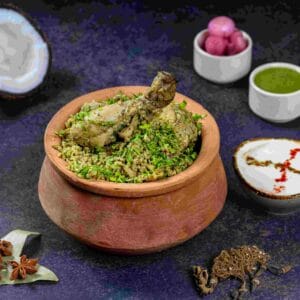Most people who cannot make the kind of money that ‘finance professionals’ do, accuse them of many wrongdoings, including ‘cooking the books’, but what derivatives analyst-turned-home chef Kalyan Gopalakrishna now cooks as a hobby, and for a living, is food worthy of a cookbook.
As a result of his efforts since 2011, when he traded the ledger for the ladle, Kalyan is now widely acknowledged as the most authoritative exponent of the ‘Naati’ (‘hyperlocal’) Cuisine of ‘Old Bangalore’. It has been nurtured in the homes and kitchens of generations of Telugu, Tamil and Marathi speakers who settled down outside what was then a British cantonment town in the mid-1800s, in what is now a vintage neighbourhood known as Cubbonpete.
The ‘Naati’ culinary tradition mirrors Bengaluru’s all-inclusive cosmopolitan society and, as Kalyan put it so evocatively in the latest episode of ‘Food Talk with Sourish Bhattacharyya’, “I speak Telugu at home, but I am a proud Kannadiga who topped in Kannada in Class X.” The tradition also reflects the love for food transmitted across generations of settler families who are now the guardians of the ‘Naati’ cuisine.
Kalyan’s family, from his father’s side, traces its roots back to the Vijayanagara Empire, where his ancestors were warriors. After the empire declined and withered away, many of them (they belonged to a caste known as the Devangs) moved into Cubbonpete and took up weaving or the textile trade as their profession.
The Devangs, in fact, are behind the fame of Bangalore silks; Kalyan’s father, however, was the first member of his extended family to become an engineer and move away from their hereditary trade. Kalyan followed in his father’s footsteps, but realised soon that engineering was not his “cup of tea” and settled for finance. He clearly had a head for numbers.
His mother’s ancestors, incidentally, moved from Bagalur village in Tamil Nadu’s Hosur district, which is now an industrial hub but was a part of the Kingdom of Mysore in the past. Kalyan says his mother’s family owned land at Bagalur, “where we used to visit a couple of times a year for a non-vegetarian feast on special occasions”. Food was the glue that brought the family together and made everyone happy.
It was this passion for good food that Kalyan carried with him to Sydney, where he worked for several years. Sydney and the variety of quality ingredients its stores and fresh markets had to offer, turned Kalyan into a serious cook, and he said on ‘Food Talk’ how his friends from across the world still remember the meals he used to dish up in Sydney.
The conversation at every meal in his family home, according to Kalyan, was about what would be eaten next. Breakfast continues to be the “biggest meal of the day” and his wife, who’s a professor of journalism, never fails to prepare it daily before setting off for her college at 7:30 a.m. The most popular breakfast item is ‘Chitranna’. Not to be confused with the tangy ‘Bisi Bele Bhaat’ that comes loaded with spicy vegetables, ‘Chitranna’ is a turmeric-coated rice preparation that those living in the North would call a ‘vegetable pulao’. “Like any typical Bangalore household, we are into rice items for breakfast,” Kalyan emphasises.
Chitranna goes best – “it’s a superb combo” – with Mutton Pepper Roast, one of the standout dishes from Kalyan’s ‘Naati’ repertoire. The dish owes its reputation to the mutton that goes into it. It’s Bannur Mutton, an exclusive and expensive variety with marbling to die for (just like what you’d get on a slab or carpaccio of Kobe beef, better known as ‘wagyu’). And it can be found in just one village – Bandur – in the Mandya district of Karnataka, just east of Mysuru.

“Before I took my flight to Gurgaon, I had just this – Chitranna and Mutton Pepper Roast,” said Kalyan, who was in town to teach the staff of We The Chefs Experiential Centre how to prepare what we describe as his ‘Naati Chicken Biryani’ (although he insists it should be called ‘Chicken Palav’). It has been a tradition in his family for Mutton Pepper Roast to be the first dish anyone has after coming home following a long stay overseas or outside Bengaluru.
“That was what my father would have whenever he returned home after a tour, or my brothers, or I, when I used to live in Sydney,” Kalyan said, adding that “the pepper opens up all your senses and you are back in action” (which is why it is also a pick-me-up when you’re recovering from an illness). Clearly, the ‘Naati’ families set their food benchmarks rather high, starting with the very best right at the start of the day.

This episode of ‘Food Talk’ came to an end with Kalyan talking about the rice variety he used for the ‘Naati Chicken Biryani’, the short-grained ‘Jeera Samba’, which is completely at the other end of the flavour pole from the aromatic Basmati, the favoured one for biryanis made in the North. He was quick to point out, though, that his family favours Basmati for biryanis, especially those made with mutton, perhaps because of his father’s exposure to North Indian food. But for the ‘Naati Chicken Biryani’, he sticks to Jeera Samba because of the way its grains absorb the flavours of the spices and the juices of the chicken.
Log on to the YouTube channel of We The Chefs to catch Kalyan Gopalakrishna on ‘Food Talk with Sourish Bhattacharyya’

